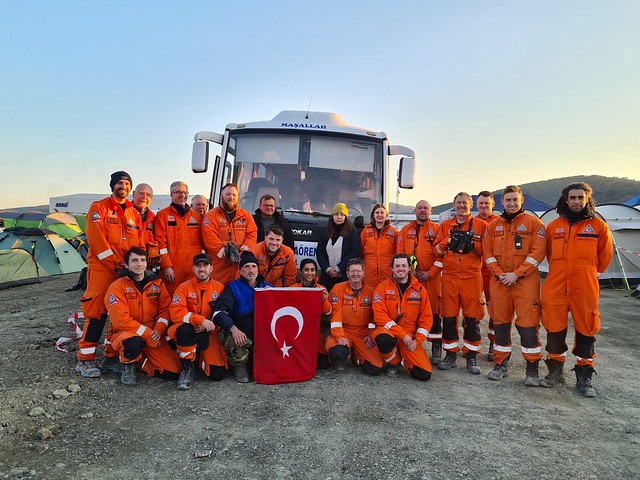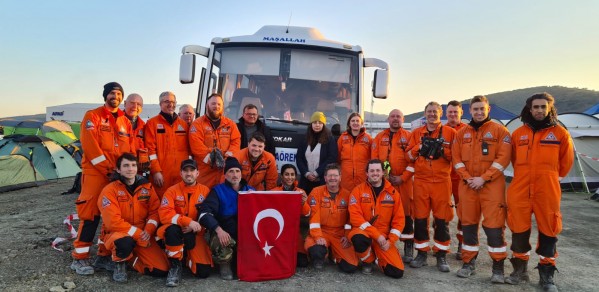
Alumna Sakthy Selvakumaran, is a civil engineer who volunteers for the charity Search and Rescue Assistance in Disasters (SARAID). She was on the ground as part of the emergency coordination search and rescue efforts in Turkey after the earthquakes earlier this year.
You're working in emergency situations to try and get as many people out as possible. But also trying to balance that with safety. The structural engineers are a safety point, because we can assess the evolving change of buildings. We think of this evolution as past, present and future load paths. What was the building? What is it like currently? Where could it go to?
Alumna Sakthy Selvakumaran
On 6 February 2023, an earthquake measuring magnitude 7.8 (Mw) struck southeast Turkey and northwest Syria, and was followed barely nine hours later by a second earthquake of magnitude 7.5 (Mw). Both events occurred on the East Anatolian Fault Zone and over the subsequent days and weeks thousands of aftershocks continued to impact the region. By 19 February, more than 41,020 fatalities had been reported, with 108,068 people injured and more than 1.2 million people displaced.
We spoke to Sakthy about the emergency coordination search and rescue efforts.
When did you join SARAID? And what prompted you to join?
I joined SARAID about three years ago, it took me about two years to train and qualify as an Urban Search and Rescue Technician. I joined because somebody I knew from my time at Engineers Without Borders was a volunteer. He's been heavily involved and together with another engineer he helped set up the engineering function within SARAID. He knew I might be interested in this kind of work. So I went along to an information session and signed up. You have to do a selection weekend which is very intense. You really need to be able to trust your team and understand how they react under stress, with no sleep, in all possible situations. If you pass the selection weekend, then you can start training.
Can you tell me about the SARAID training.
It takes about two years to get all the skills, some of it is theory for example understanding the United Nations (UN) system on how to deploy, understanding the coordination and the management. Some of it is practical, safety skills, how to conduct searches, technical skills like how to use the equipment for listening into collapsed buildings. We use drills and disc cutters and practice cutting through concrete in different ways doing simulations imagining the possible casualties within to make sure that we can use machinery in a safe way. Every so often, we go and train at the fire service college in Moreton-in-Marsh. They have a simulated disaster area, basically a rubble pile, broken buildings and a burnt out building. We can practice our rope work and practice getting casualties out of a building or the rubble pile through various simulation exercises that they've set up.
Some of us have additional skills and are qualified outside of SARAID such as medics and engineers who are professionally qualified in their own fields.
After the selection weekend you train for one weekend once a month and the engineers have training online in between. So it's a minimum once a month commitment over a two year period.
At the end of last year, our SARAID team was classified as an official ‘Light’ team. Classified ‘Light’ USAR teams are now a recognised as part of the International Search and Rescue Advisory Group (INSARAG) network that includes Light, Medium and Heavy international Urban Search and Rescue (USAR) teams.
Was this your first trip with SARAID?
It was my first in-person deployment. I've previously been part of the SARAID UK support team for the Haiti earthquake 2021 and the Beirut blast in 2020 where I was part of the SARAID team doing damage assessment coordination based in the UK.
Previous to joining SARAID I have done post-disaster earthquake reconstruction work in Latin America with an organisation called PREDES. But this was the first time being on the ground immediately after a disaster for the search and rescue part of it.
Can you tell me about the preparation that was needed before you left for Turkey?
SARAID monitors for big events 24 hours a day, seven days a week. The UN has a system where they coordinate and start putting out information to all international teams. So at that point, SARAID asks who’s available to deploy. That usually depends on whether people can get time off work and that kind of thing. SARAID volunteers always have a bag packed and are ready to go.
And then we only deploy if we have permission from the local country, the country invites us to come as a request for assistance.
Can you explain the procedures that you follow when you reach a rescue mission such as this?
Because it was such a big disaster there was a base of operations for international rescue teams. SARAID were in the Turkish city Kahramanmaraş in one of the sub-coordination cells, coordinating with the local teams, the UN and other international teams. The affected areas are mapped into different sectors (depending on the amount of damage in an area), and then different international teams are allocated to different sectors. Sectors with lots of damage, you'll send lots of people there. If it's likely to be less damage send less teams there. Then through that you identify where people are likely to be stuck. Then you can set up work sites and start extricating people, or getting teams with additional resources to support. You also have to bear in mind that obviously, local people will be providing information from the ground as well. We responded to a site because somebody heard a phone ringing in a pile of rubble. And the long story short, is we pulled out a 15 year old girl out of a rubble pile from several stories down in a collapsed building.
Can you describe the situation in Turkey when you arrived?
We flew into Istanbul and then flew to Adana which was largely unaffected. Then we began what the driver told us was normally a two hour drive, but became a seven hour drive to Kahramanmaraş. As we got closer the number of fallen buildings increased then by the time we got to the centre of Kahramanmaraş, there were lots of buildings completely destroyed. The city centre was the predominant area that we were working in.
In the surrounding countryside, you get the odd house here and there that has collapsed. But a lot of the rescue work that happens in the first 24 hours is done by the local people. Either people have died, or they have been pulled them out by neighbours and people in the area. A lot of our work was focused on the city centre, the severe damage, large apartment buildings completely toppled and some had completely pancaked, upside down, all sorts.
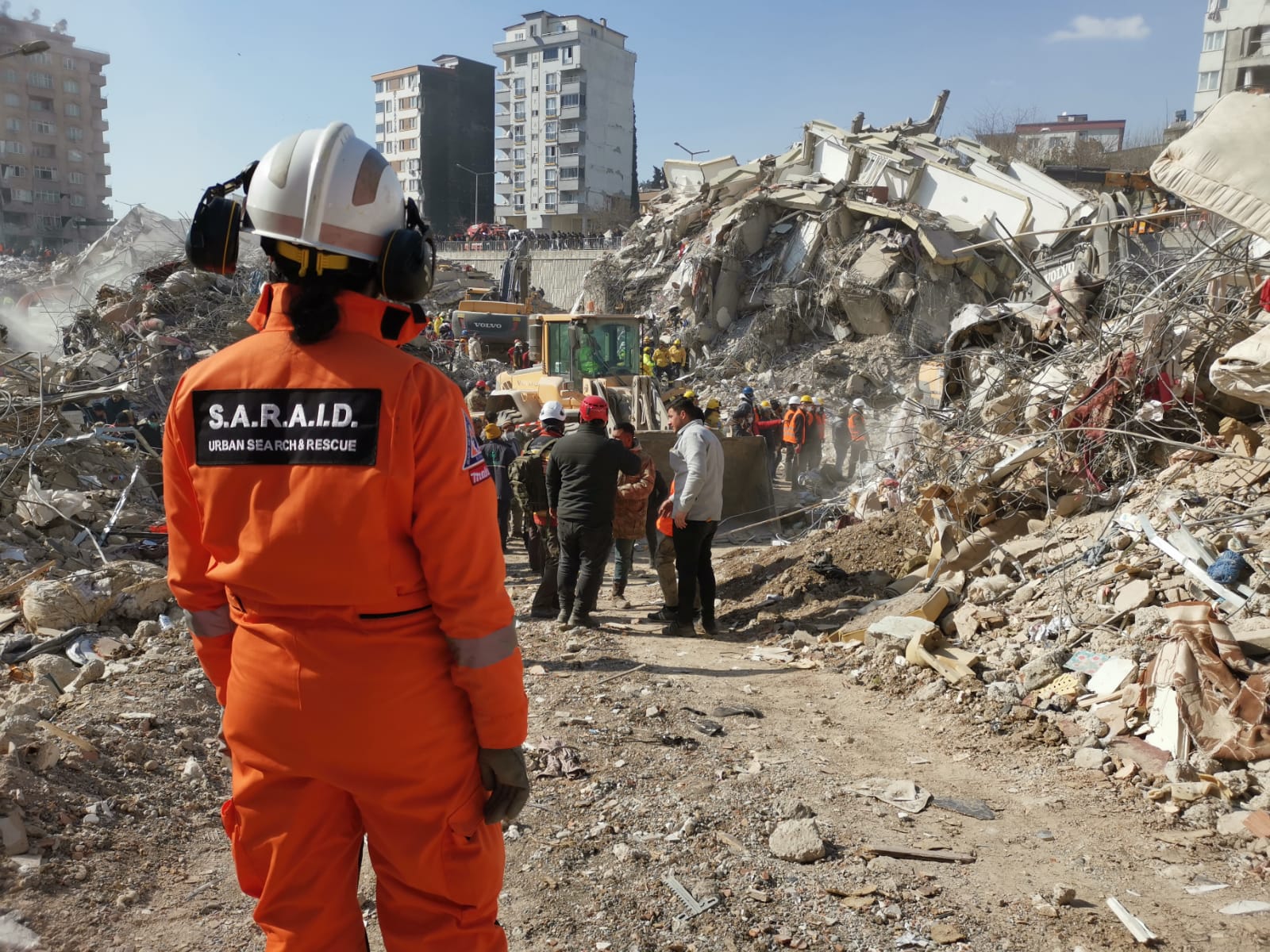
So what were the biggest humanitarian concerns?
You're working in emergency situations to try and get as many people out as possible. But also trying to balance that with safety. The structural engineers are a safety point, because we can assess the evolving change of buildings. We think of this evolution as past, present and future load paths. What was the building? What is it like currently? Where could it go to? After that period of rescue then comes the bigger humanitarian response. So bearing in mind that there’s the immediate tragedy of people dying and losing family members, and then the next stage of response is going to take so many years to get people re-housed, recover their livelihood, etc.
One of my friends at Engineers Without Borders, Tom Newby, who is also a Cambridge engineering alumnus, used to be Head of Humanitarian at Care International and he was telling me that for engineers, it's often quite tempting to think about designing a novel shelter or donating various items but in reality, the best thing you can do is send money, because people can use money to either travel to go and live with relatives, or to rent a hotel room, or to invest in getting themselves back up and out of being in a tense situation.
How is the rescue equipment able to get through to where it is needed?
It was quite well organised. The Turkish government’s Disaster and Emergency Management Authority (AFAD) is an institution working to prevent disasters and minimise disaster-related damages, plan and coordinate post-disaster response, and promote cooperation among various government agencies. So the Turkish disaster infrastructure was quite well set up. A lot of teams flew into Adana. On arrival normally the questions are how do we get transport? How do we get fuel? SARAID is fully self-sufficient while in deployment except for transport, fuel and access. When we got there, we were able to arrange transport and fuel easily. AFAD had set up an area to be the base of operation where we put all of our tents and supplies. From there we could gain access. We arrived a couple of days after the first earthquake and there were a lot of diggers and cranes moving rubble out of the way. So access was created fairly quickly. Our SARAID team mobilised about 30 hours after the earthquake, and we arrived in 2 waves. Initially a team of six people went out, and then the second team was 12 of us.
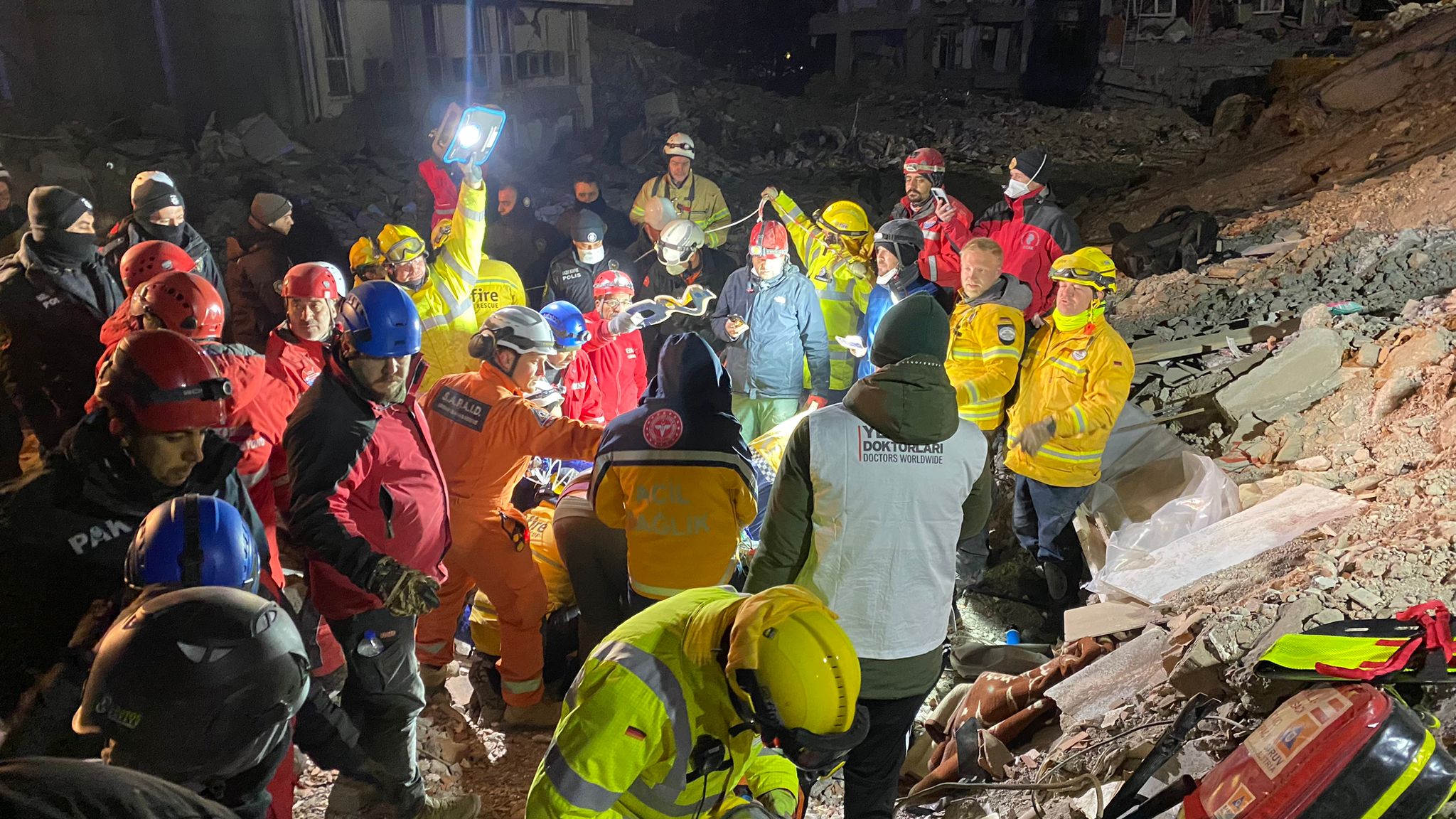
How many rescue teams were there on the ground? And how do these different international rescue agencies work together?
So ideally, everything is UN and local national organised. The local emergency management authority (which varies from country to country), are in charge of their country. The sovereignty of the affected country is guaranteed and the international responders, including UN, are not in charge. Most qualified teams work under the United Nations Office for Disaster Risk Reduction. The international community decided there needs to be some way of coordinating disasters and so they set up a system where we all get trained to a certain level. We have this central coordination team online and in-person. And you decide your sectors. We have forms that have now gone online and access to Geographic Information System (GIS). mapping to start tagging areas where people are. The International Committee is trying to work together.
How are local people utilised in the rescue efforts?
In Turkey there are plenty of highly trained skilled people. So they're on the ground first. The damage assessment was coordinated by AFAD and the govenrment using local Turkish engineers. In terms of the general public, they're involved in the first 24 hours pulling out as many people as they can. They have a slightly different perspective on safety. So they were all over the place and in quite dangerous situations, but all desperate, trying to find as many people as they could. The Turkish people were in such a hard set of circumstances, such lovely people, everybody was trying to support each other and do the right thing.
Sometimes when using certain bits of search equipment, you have to have quiet because you're trying to listen to whether somebody's tapping in a building. The emergency workers are all dressed in emergency workers uniform so when they yell ‘silence’ the crane and the bulldozers switch off everyone will be silent.
How long were you in Turkey?
About a week. We were told before we left that we would be gone for approximately seven days. If something happens, we might extend this. Because we are a ‘Light Team’. It means that it's great in some respects, because we can mobilise and be in country very quickly. We fly using local commercial airlines. For this trip the flights were donated by Airlink and the excess baggage was donated by Pegasus airlines. We could move and get our equipment and be on site very quickly, which is good at the beginning, when you’re trying to go through lots and lots of buildings and identify people, then later you have much larger teams from the American, Chinese, UK, Israeli governments. These are huge teams for big disasters you need sheer people power. And so they tend to do the bigger jobs. SARAID are well suited to the early phase and response, identify where things are, and helping rescue. By the time we were leaving, there were fewer and fewer people being pulled out. A lot of the bigger teams have moved in to do body recovery.
Do other countries have the equivalent of SARAID with ‘light’ teams that can get to disasters early?
It's actually a relatively new concept. Up until very recently, there was no Light Team qualification, you were either qualified as a Heavy Team or as a Medium Team, but Light didn't exist. SARAID qualified recently. The Light classification is for small teams that can cover a range of things and move quickly. The SARAID teams don't have rescue dogs so we tend to partner with other Light Teams for example the German Light Team called @fire. In Turkey, the @fire engineer got very, very tired at one point, so we swapped the engineering role. And then at one point, we needed a dog. And so they brought in their dog. Teams collaborate and work together.
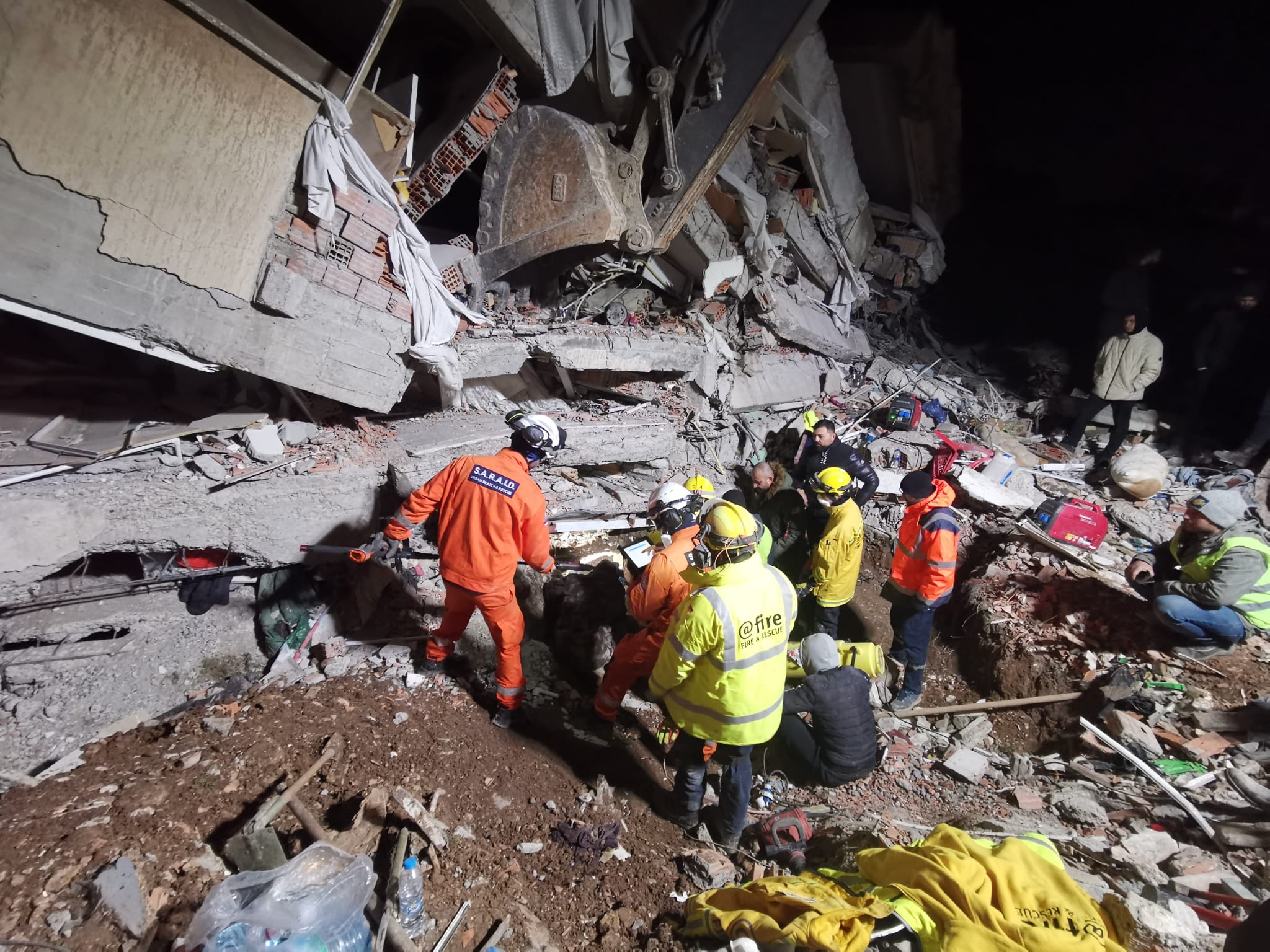
What would you tell someone who wants to volunteer for an organisation like SARAID but doesn't know how to begin?
They're always welcome to speak to existing members, it's definitely something that's not for everyone. It's quite a particular way of volunteering. There are plenty of other ways where people can make a difference without necessarily having to be part of the rescue missions on the ground. A big part of the response was the people in the UK organising logistics, dealing with the equipment, doing a lot of research. Before I went out, I was trying to understand what kinds of structures would be there, doing research, other SARAID volunteers updated the maps. They updated the maps on a daily basis to try and understand where the hazards were and where everything was.
There are people also coordinating with our loved ones back home, as we shouldn't really be speaking back and forth with our loved ones during deployment (and sending mixed messages) so coordinating all the people at home and keeping them informed is a useful job. There was so much work done by SARAID volunteers here in the UK as well as the volunteers in Turkey. So there's a mixture of roles and help needed including media and fundraising.
Over 3 months have passed since the earthquake struck. What are the most urgent needs now?
There are organisations doing damage assessment. The key things are obviously getting people back into their homes, getting people back to their lives. Also things like damage assessment for insurance and making sure that people can claim funding to rebuild and re-home.
I have done post-disaster reconstruction work. I was working in Peru two years after the Ica earthquake, there were still people living in tarpaulin shelters. So they can't really move on with their life and that’s a long time to wait in temporary circumstances.
Then there's a lot of questions about why this happened? It was a big disaster. In Turkey, USAR teams were able to rescue hundreds of people from collapsed buildings as a combination of the effort of the local population, local emergency teams and national and international USAR teams.
However, the earthquake is a stark reminder of the important role owners, designers, contractors and operators play in providing resilient buildings and infrastructure, and the potential consequences when a disaster strikes.
Turkey is an earthquake-prone area and whilst Turkey has strong seismic building design codes, the Turkish government offered amnesties for violations of the building code, allowing non-compliance to continue with the payment of a fee. This poor enforcement of seismic codes was a contributing factor to the devastation of the 2023 Turkey–Syria earthquakes. There were high incidences of support column failure leading to ‘pancake’ collapses, which complicated rescue efforts.
Unreinforced masonry buildings are vulnerable. Retrofitting old buildings is possible but expensive. Although over 3 million housing units nationwide were strengthened in the 2 decades before 2023, many apartment blocks do not meet 21st century standards.
Over the coming months there will be questions around whether many of the affected buildings were designed and constructed in compliance with those codes. There were also measurements that show that some of the earthquake events were beyond what we would have designed for, even for well-built buildings. So the cause of this scale of devastation is mixed and complicated.
Disasters such as these earthquakes result from a combination of natural hazards and societal, human vulnerability. The challenge for engineers is how we can adapt for future design and construction.
The actual seismic event was much larger event than could have been predicted. Mother Nature, setting the bar just a little bit higher for us. This has a lot of implications on how we think about resilience, the world is changing.
You can find out more about SARAID and donate on their website here.

